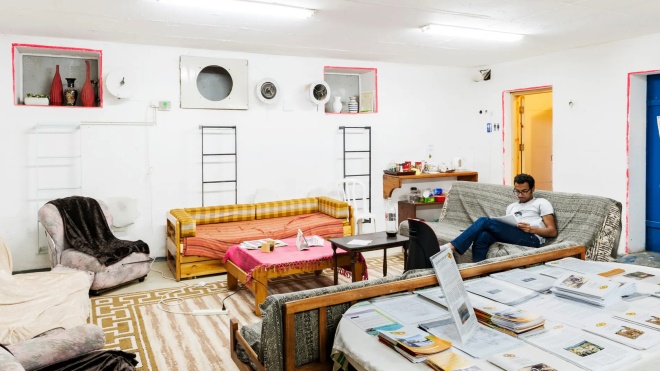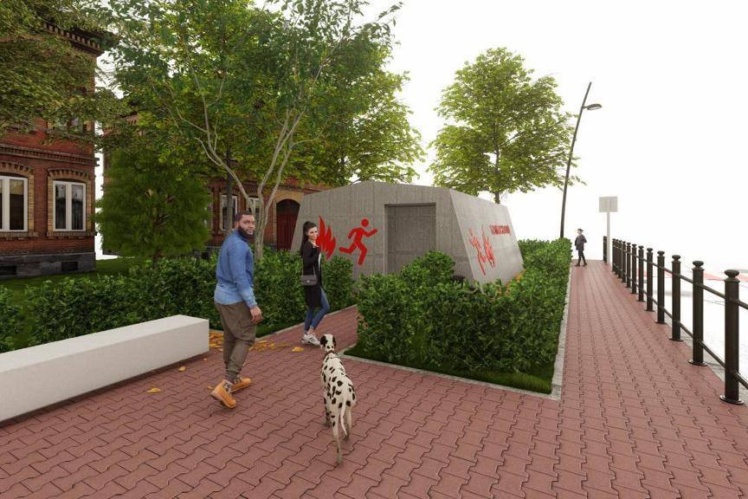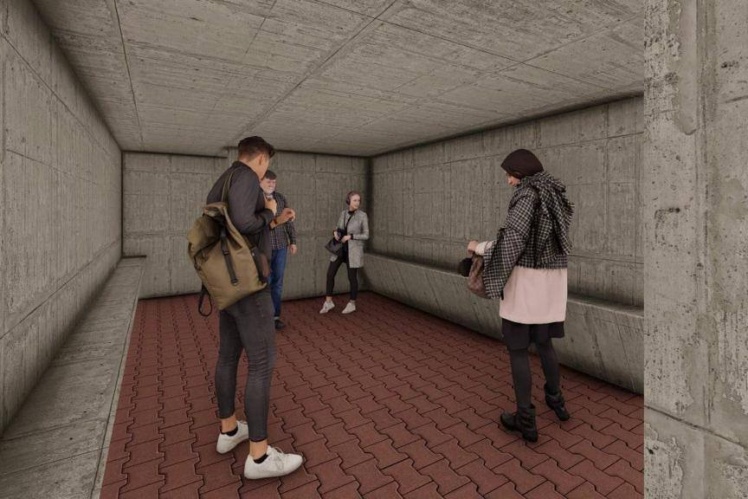What does a mamad look like?
An ordinary mamad is a security room in an apartment. Not some kind of separate, but of dual purpose — all the time before and after the alarm, it is an ordinary living room. Preferably a bedroom, because air alarms often happen at night. In a multi-story building, the mamads are built one above the other and form a whole riser of fortified rooms, which must withstand if the rest of the building begins to collapse.
Israeli house with additional fortification. A building in Haifa reinforced according to Tama-38.
All mamads are built according to the norms and standards approved by the Rear Command of the Israel Defense Forces. They should have reinforced concrete walls 20-30 cm thick, explosion-proof doors and windows. Most often, the doors are double — there are ordinary room ones and two of welded steel that close only in case of an alarm. The windows are also double — in case of danger, steel plates are lowered on reinforced bearings. They should also be airtight to protect not only from debris, but also from poisonous substances. The windows should also have thick impact-resistant glass.
For this purpose, a mamad has a ventilation and filtration system against biological and chemical weapons, as well as against radiation pollution due to a nuclear strike. Mamad should be designed in such a way that the whole family, in total at least six people, can easily accommodate there. Therefore, the area of such a room should be at least 9 square meters, and the ceiling height is not lower than 2.5 m. Windows should be located not lower than 1.5 m from the floor.
For buildings that appeared between 1980 and 1992, the TAMA-38 Israeli government program is in effect. A private developer can complete the mamads, strengthen the facade of the building, add elevators, and generally renovate the house. And for this, it is allowed to build another 1-2 floors with new apartments, which will be its property. This requires the consent of at least 75% of the residents of the building. Any citizen can build a mamad privately, but it is quite expensive — about 150,000 shekels.
Construction of the Merhav Mugan Dirati fortified premises in Sderot as an addition to the existing building, made against Qassam missiles.
At the beginning of 2022, 40% of apartments in Israel have mamads. In addition to private, apartment buildings, Israel also builds momaks — warehouses for office, industrial or other public buildings, which usually occupy an entire floor.
Why are the mamads a good solution for Israel?
The main danger of rocket attacks on Israel is that the rocket arrives very quickly. For example, in August 2021, rockets hit the northern part of Israel from southern Lebanon. From the city of Haifa to the Lebanese border is less than 30 km. And in the south, near the Gaza Strip, less than a minute can pass from the launch of a rocket to its arrival.
Wreckage of a bus and a car in Holon after a rocket attack.
“When the air-raid siren sounds, a person has up to 60 seconds, depending on the distance to the area from which the missiles were launched, to get to the safety room. Basements are not suitable for protecting the civilian population in Israel, because people need to get to a safe place extremely quickly," says Ravid Brosh, Head of International Business Development at RB-Doors (Rav-Bariach group).
And in the southern cities of Israel, for example in Sderot, the rocketʼs approach time can be no more than 15 seconds. In addition, the threat of chemical attacks remains high in Israel. The Bashar al-Assad regime in Syria has used chemical weapons more than 200 times since 2011. Not against Israel -- against the internal opposition. But the Israelis take such a threat seriously and are preparing for attacks. Basement storage is not reliable in this case.
An Israeli family in their security room (merhav mughan) wearing gas masks during the alert.
Wikimedia
On June 21, 2013, missiles containing sarin, a military poison, were hit in the suburbs of Damascus in areas controlled by rebels against the Assad regime. The same attacks in Syria were repeated in 2018. Sarin sinks down and spreads over the surface, so basements can be a dangerous place. And mamad can fully protect against such an attack. Once upon a time, the threat of using chemical weapons by Saddam Husseinʼs regime in Iraq became one of the factors that led to the emergence of the mamads.
In Israel, there are still many public bomb shelters — miklats, which the country has been building since its foundation in 1948. But the Israeli government explicitly recommends a family to have its own security room, even in older buildings where it is not required by law. Because there may be just not enough time to run to the bomb shelter. And on days when air alarms are frequent, some people find it banal and lazy to constantly run to the basement. It is much easier to go to the next room.
By the way, the Israeli experience with shelters is already gradually penetrating into Ukraine. At the end of July 2022, the mayor of Kharkiv Ihor Terekhov announced that 25 reinforced concrete shelters will be built in the city at public transport stops. Such shelters will protect citizens from shrapnel in the event of shelling.
Telegram / Ігор Терехов
Are mamads in apartments suitable for Ukraine?
This is a difficult question. Ukraine and Israel are fired at with very different weapons — the power of Russian missiles is much greater than those that terrorists usually launch at Israel.
"Israel is most often fired at not by Iskanders or X-101s, but by much more primitive things. These are either home-made missiles of the Qassam; type, or in general shells from Grads, only not in a volley, but in single shots. Mamad protects well against such weapons. Even if Qassam damages part of the building somewhere, the "candle" of the mamads will stand. In the same way, mamad will protect against a shot from a tank, for example. But it cannot protect against cruise missiles that can destroy the entire building. Like in Kremenchuk, where the X-22 flew only to the edge of the shopping center and completely destroyed the entire building," Israel Defense Forces officer and military analyst Yihal Levin tells Babel.
He believes that the mamads could really save many lives in the front-line Ukrainian cities and where hostilities are currently taking place. But building them there is a task for many years, and it should have started a long time ago. The Russians are shelling other cities of Ukraine with extremely powerful weapons.
"People should be evacuated from cities where hostilities are taking place, this is the best protection. By the way, when Israel was not fighting against terrorists with homemade rockets, but against Egypt, which had Tu-16 bombers with high-explosive bombs, they did not build mamads. They built underground bomb shelters, on several floors, with water supply and everything else. Theyʼre still there, theyʼre just not used, because when youʼre being shot at by Qassams, thereʼs no need for big bomb shelters," says Levin.
In addition, Yihal Levin believes that there is also an economic component in this issue. Israel pays large compensations and social assistance to all citizens affected by shelling and their families. Therefore, it turned out to be cheaper for the state to protect citizens with bombs, which cost less than large bomb shelters and fully protect against terrorist shells. But Ukraine needs to carefully weigh all options for protection against shelling, taking into account Russian weapons, the time of arrival of missiles to various cities, and the economic aspect.
"It is definitely necessary to build bomb shelters in Ukraine. But we must also remember that nothing can replace a full-fledged bomb shelter, except, in fact, a bomb shelter," says Yihal Levin.
A bomb shelter in a dormitory of Tel Aviv University, Israel.
Wikimedia
Translated from Ukrainian by Anton Semyzhenko.
Shelters save peopleʼs lives, and your donations keep Babel inspired and give a feeling of support: Patreon 🔸 [email protected]🔸donate in cryptocurrency🔸in hryvnia.




